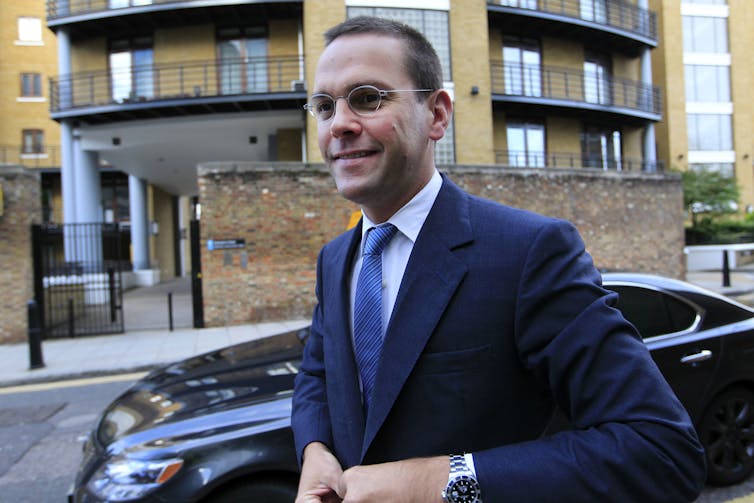Source: The Conversation (Au and NZ) – By Gabi Mocatta, Research Fellow in Climate Change Communication, Climate Futures Program, University of Tasmania, and Lecturer in Communication – Journalism, Deakin University

Justin Lane/EPA/AAP
Australia’s Murdoch-owned tabloid newspapers – including The Daily Telegraph, Herald Sun and Courier Mail – have embarked on a bold new climate change campaign.
This climate rebrand, dubbed “missionzero2050”, is billed by the company as “putting Australia on a path to a net zero future”.
The change has surprised Australian media observers and, no doubt, media consumers given News Corp’s long-held climate denialist stance, which is well documented in public commentary and research.
So why is this happening now? And what does it mean?
What does the new campaign say?
Last Monday, News Corp’s tabloid mastheads began the new campaign with a 16-page wraparound supplement and a splashy online campaign championing the drive to cut climate warming emissions by 2050.
Read more:
What is COP26 and why does the fate of Earth, and Australia’s prosperity, depend on it?
News Corp must have done its climate communication research. It has assembled a collection of stories using best-practice climate communication techniques: telling a global story with a local face, visualising climate impacts and focusing on solutions, not creating fear.
Crucially, the campaign marks a change from News Corp’s long-held position on climate action. It’s moved from calling decarbonisation too expensive and bad for jobs (it tagged the cost at A$600 billion in 2015), to describing it now as a potential $2.1 trillion economic “windfall”, offering opportunities for 672,000 new jobs.
News Corp and climate change
What News Corp does matters, because it has extensive influence in Australia’s media market.
The company’s newspaper, radio, pay TV and online news portfolio gives it significant audience reach and huge political sway. In April, former Prime Minister Malcolm Turnbull labelled the Murdoch media “the most powerful political actor in Australia”.
Most people derive their understanding of climate change from the media. So News Corp’s audience reach (which included about 100 print and digital mastheads as of early 2021) has given it extensive influence over Australians’ knowledge of and opinions about climate change, profoundly shaping public debate.
Murdoch media outlets have denied the science of climate change and ridiculed climate action for more than a decade.
A 2013 study by the Australian Centre for Independent Journalism found climate denialist views in a third of Australian media coverage of climate change, and pointed to News Corp outlets as the key reason for this.
News Corp’s commentators have described those arguing for climate action as “alarmists” and “loons”, who are prone to “warming hysteria”. They have also said climate concern is a “cult of the elite” and the “effects of global warming have so far proved largely benign”.
Despite this, in 2019, Murdoch declared there were “no climate change deniers” in his company.
Signs of a mood shift
This pivot on climate change was not entirely unexpected.
The company had been signalling a mood shift since early 2020, in the wake of its controversial reporting on the Black Summer bushfires, which saw it accused of downplaying the fires and fuelling misinformation about the cause.

Sang Tan/AP/AAP
At that time, Rupert Murdoch’s son James expressed his concerns about the “ongoing denial” of climate change at News Corp in the face of “obvious evidence to the contrary”.
He subsequently resigned his position on the company’s board. Early last month, the Nine newspapers flagged an imminent change of stance on climate at News Corp, noting, “Rupert Murdoch’s global media empire has faced growing international condemnation and pressure from advertisers over its editorial stance on climate change”.
The fine print
Despite the gloss of missionzero2050 (the newspapers say they are only focusing on “positive stories” about creating “a clean future while having fun and feeling good at the same time”), a deeper analysis shows the campaign has some quite specific agendas, signalling its climate epiphany may be limited.
In the stories that make up the campaign, it is still rolling out business-as-usual narratives like:
-
defending Australia’s emissions as small compared to other countries, especially China (therefore suggesting we do not need to take drastic action)
-
framing renewables as an unreliable source of energy (so not an adequate replacement for fossil fuels)
-
promoting Australia’s coal as cleaner than other countries’ (some of it may be, but the International Energy Agency says the world must start quitting coal now to stay within safer global warming limits)
-
promoting gas as having half the emissions of coal (burning gas does emit less carbon dioxide, but its extraction also causes fugitive emissions of methane, a gas that’s about 30 times more powerful as a heat-trapping greenhouse gas than carbon dioxide over 100 years)
-
advocating carbon capture and storage (which is not yet a proven way to reduce emissions from burning fossil fuels)
-
criticising a carbon pollution price (economists widely agree this is the single most effective way to encourage polluters to reduce greenhouse gas emissons).
Read more:
Australia’s top economists back carbon price, say benefits of net-zero outweigh cost
Surprisingly, the campaign is making a big effort to spruik nuclear power. It states: “our aversion to nuclear energy defies logic” and advocates strongly for an Australian nuclear industry for “national security” purposes as well as energy.
Overall, the missionzero2050 agenda seems to be set on supporting new and existing extractive industries and Prime Minister Scott Morrison’s “gas-led recovery”.
Strangely, the campaign also emphasises “putting Australia first” – although efforts to deal with climate change must be inherently globally focused.
Loud silences
What’s most perverse, perhaps, about missionzero2050 are the things it does not say or acknowledge. There has been no mention of News Corp’s years of intentionally undermining decarbonisation and helping to topple Australian leaders who advocated for climate action.
Oddly, News Corp has not muzzled its high-profile commentators. Columnist Andrew Bolt was quick to make it known that he thought the campaign was “rubbish”.
Nor has it aligned its advertising with the missionzero2050 message. For example, last Wednesday, the Herald Sun ran a half-page ad placed by the climate “sceptical” Climate Study Group about the “great climate change furphy,” discrediting climate science and advocating for more coal and nuclear power.
What might it mean?
The timing of the campaign, just as Morrison negotiates with the Nationals ahead of the COP26 climate conference, is likely to be no coincidence. It seems designed to provide cover for a potential shift on the part of the Coalition towards a mid-century net zero declaration.
Morrison is also under intense pressure from other world leaders to lift his ambitions on climate. He’ll be expected to bring new plans for emissions cuts to the table in Glasgow.
Some commentators have labelled the Murdoch pivot “greenwashing”. Others have called it a “desperate ploy to rehabilitate the public image of a leading climate villain”.
However perplexing the Murdoch papers’ climate U-turn may seem, at least Morrison will know Australia’s “most powerful political actor” is not likely to campaign against any 2050 net zero declaration.
Given News Corp’s power to subvert the national narrative on climate, that’s important if we want to see the action that’s so long overdue.
![]()
Gabi Mocatta is co-lead of Deakin University’s Climate Change Communication and Narratives Network. She is also vice-president of the Board of the International Environmental Communication Association.
– ref. What’s behind News Corp’s new spin on climate change? – https://theconversation.com/whats-behind-news-corps-new-spin-on-climate-change-169733







